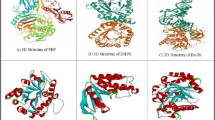Abstract
Antifungal drugs are inhibitors either of fungal cell wall biosynthesis or essential reaction steps of fungal metabolic pathways. In silico studies have proved to be very effective on screening small molecules to be used as drugs and identifying essential reactions and pathways as targets. The aim of the present study was to predict the interactions of compounds present in the ethyl acetate extract of Streptomyces sp. VITSTK7 against selected fungal drug target enzymes. The ethyl acetate extract of the isolate showed significant anti-Aspergillus activity against the selected Aspergillus pathogens. Presence of the three compounds (C22H37NO7, C17H24N4O6 and C24H28N2O5) in the extract was identified by GC-MS spectra and matched with reference compounds available in the MS spectra library, NIST (National Institute for Standards and Technology). These compounds were analysed for the interaction with five selected fungal target proteins 1AFR, 1EA1, 1LKP, 1ZHX and 3PD73i3E. Docking was done using Patch dock beta 1.3 version and analysed by pymol 1.3 version. The tested compounds C22H37NO7, C17H24N4O6 and C24H28N2O5 showed least binding energy of −254.64 kcal/mol, −248.71 kcal/mol and −338.57 kcal/mol respectively with 1ZHX. The result of this study revealed that all the three compounds from the strain had higher interaction with 1ZHX protein than with the other proteins. It shows that this strain could be the promising source for the antifungal drug.
Similar content being viewed by others
References
Alexander, B.D., Perfect, J.R. 1997. Antifungal resistance trends towards the year 2000. Implications for therapy and new approaches. Drugs 54, 657–678.
Deepak, K.J., Likun, P., Sarika, R., Devyani, S., Anand, A. 2011. Molecular docking approach to locate the potent anti-leishmanial agent. J Pharm Res 4, 2003–2006.
Kumar, S., Kannabiran, K. 2010. Antifungal activity of Streptomyces VITSVK5 spp. against drug resistant Aspergillus clinical isolates from pulmonary tuberculosis patients. J Mycol Med 20, 101–107.
Kumar, S., Kannabiran, K. 2011. Interaction of 5-(2,4-dimethylbenzyl) pyrrolidin-2-one with selected antifungal drug target enzymes by in silico molecular docking studies. Interdiscip Sci Comput Life Sci 3, 198–203.
Petrikkos, G., Skiada, A. 2007. Recent advances in antifungal chemotherapy. Internat J Antimicrob Agents 30, 108–117.
Thenmozhi, M., Kannabiran, K. 2010. Studies on isolation, classification and phylogenetic characterization of novel antifungal Streptomyces sp. VITSTK7 in India. Curr Res J Biol Sci 2, 306–312.
Thenmozhi, M., Kannabiran, K. 2011. Anti-Aspergillus activity of Streptomyces spp. VITSTK7 isolated from Bay of Bengal coast of Puducherry, India. J Nat Env Sci 2, 1–8.
Thykaer, J., Andersen, R.M., Scott, E.B. 2009. Essential pathway identification: From in silico analysis to potential antifungal targets in Aspergillus fumigatus. Medl Mycol 47, 80–87.
White, T.C., Marr, K.A., Bowden, R.A. 1998. Clinical, cellular, and molecular factors that contribute to antifungal drug resistance. Clin Microbiol Rev 11, 382–402.
Wingard, J.R., Merz, W.G., Rinaldi, M.G., Miller, C.B., Karp, J.E., Saral, R. 1993. Association of Torulopsis glabrata infections with fluconazole prophylaxis in neutropenia bone marrow transplants. Antimicrob Agents Chemother 37, 1847–1849.
Wingard, J.R., Merz, W.G., Rinaldi, M.G., Johnson, T.R., Karp, J.E., Saral, R. 1991. Increase in Candida krusei infection among patients with bone marrow transplantation and neutropenia treated prophylactically with fluconazole. N Engl J Med 325, 1274–1277.
Xiao, Z.P., He, X.B., Peng, Z.Y., Xiong, T.J., Peng, J., Chen, L.H., Zhu, H.L. 2011. Synthesis, structure, molecular docking, and structure-activity relationship analysis of enamines: 3-Aryl-4-alkylaminofuran-2(5H)-ones as potential antibacterials. Bioorg Med Chem 19, 1571–1579.
Zhang, C., Vasmatzis, G., Cornette, J.L., DeLisi, C. 1997. Determination of atomic desolvation energies from the structures of crystallized proteins. J Mol Biol 267, 707–726.
Author information
Authors and Affiliations
Corresponding author
Rights and permissions
About this article
Cite this article
Thenmozhi, M., Kannabiran, K. Interaction of Streptomyces sp. VITSTK7 compounds with selected antifungal drug target enzymes by in silico molecular docking studies. Interdiscip Sci Comput Life Sci 5, 145–149 (2013). https://doi.org/10.1007/s12539-013-0163-z
Received:
Revised:
Accepted:
Published:
Issue Date:
DOI: https://doi.org/10.1007/s12539-013-0163-z




